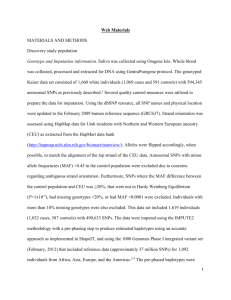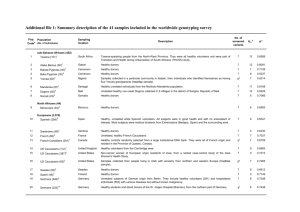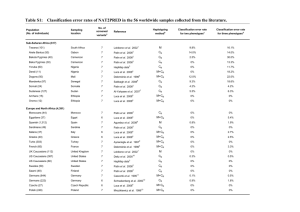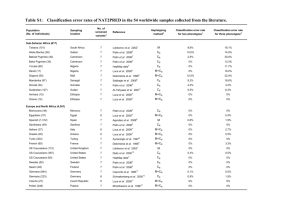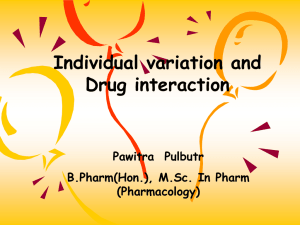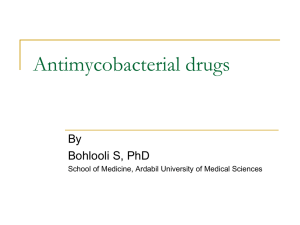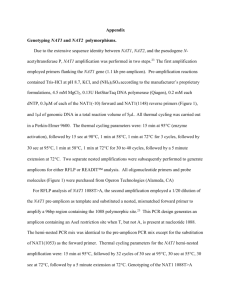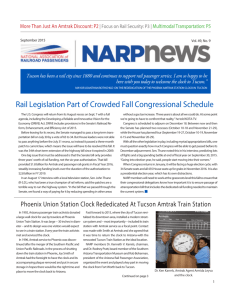Document 13310679
advertisement
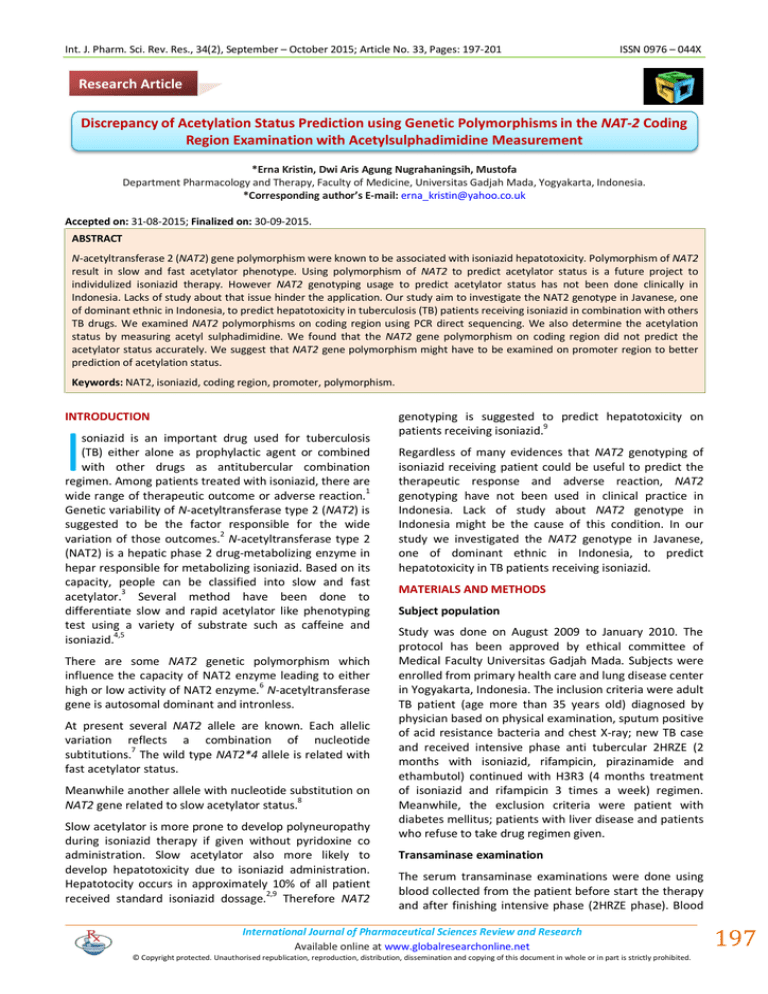
Int. J. Pharm. Sci. Rev. Res., 34(2), September – October 2015; Article No. 33, Pages: 197-201 ISSN 0976 – 044X Research Article Discrepancy of Acetylation Status Prediction using Genetic Polymorphisms in the NAT-2 Coding Region Examination with Acetylsulphadimidine Measurement *Erna Kristin, Dwi Aris Agung Nugrahaningsih, Mustofa Department Pharmacology and Therapy, Faculty of Medicine, Universitas Gadjah Mada, Yogyakarta, Indonesia. *Corresponding author’s E-mail: erna_kristin@yahoo.co.uk Accepted on: 31-08-2015; Finalized on: 30-09-2015. ABSTRACT N-acetyltransferase 2 (NAT2) gene polymorphism were known to be associated with isoniazid hepatotoxicity. Polymorphism of NAT2 result in slow and fast acetylator phenotype. Using polymorphism of NAT2 to predict acetylator status is a future project to individulized isoniazid therapy. However NAT2 genotyping usage to predict acetylator status has not been done clinically in Indonesia. Lacks of study about that issue hinder the application. Our study aim to investigate the NAT2 genotype in Javanese, one of dominant ethnic in Indonesia, to predict hepatotoxicity in tuberculosis (TB) patients receiving isoniazid in combination with others TB drugs. We examined NAT2 polymorphisms on coding region using PCR direct sequencing. We also determine the acetylation status by measuring acetyl sulphadimidine. We found that the NAT2 gene polymorphism on coding region did not predict the acetylator status accurately. We suggest that NAT2 gene polymorphism might have to be examined on promoter region to better prediction of acetylation status. Keywords: NAT2, isoniazid, coding region, promoter, polymorphism. INTRODUCTION I soniazid is an important drug used for tuberculosis (TB) either alone as prophylactic agent or combined with other drugs as antitubercular combination regimen. Among patients treated with isoniazid, there are wide range of therapeutic outcome or adverse reaction.1 Genetic variability of N-acetyltransferase type 2 (NAT2) is suggested to be the factor responsible for the wide variation of those outcomes.2 N-acetyltransferase type 2 (NAT2) is a hepatic phase 2 drug-metabolizing enzyme in hepar responsible for metabolizing isoniazid. Based on its capacity, people can be classified into slow and fast acetylator.3 Several method have been done to differentiate slow and rapid acetylator like phenotyping test using a variety of substrate such as caffeine and isoniazid.4,5 There are some NAT2 genetic polymorphism which influence the capacity of NAT2 enzyme leading to either high or low activity of NAT2 enzyme.6 N-acetyltransferase gene is autosomal dominant and intronless. At present several NAT2 allele are known. Each allelic variation reflects a combination of nucleotide subtitutions.7 The wild type NAT2*4 allele is related with fast acetylator status. Meanwhile another allele with nucleotide substitution on NAT2 gene related to slow acetylator status.8 Slow acetylator is more prone to develop polyneuropathy during isoniazid therapy if given without pyridoxine co administration. Slow acetylator also more likely to develop hepatotoxicity due to isoniazid administration. Hepatotocity occurs in approximately 10% of all patient received standard isoniazid dossage.2,9 Therefore NAT2 genotyping is suggested to predict hepatotoxicity on patients receiving isoniazid.9 Regardless of many evidences that NAT2 genotyping of isoniazid receiving patient could be useful to predict the therapeutic response and adverse reaction, NAT2 genotyping have not been used in clinical practice in Indonesia. Lack of study about NAT2 genotype in Indonesia might be the cause of this condition. In our study we investigated the NAT2 genotype in Javanese, one of dominant ethnic in Indonesia, to predict hepatotoxicity in TB patients receiving isoniazid. MATERIALS AND METHODS Subject population Study was done on August 2009 to January 2010. The protocol has been approved by ethical committee of Medical Faculty Universitas Gadjah Mada. Subjects were enrolled from primary health care and lung disease center in Yogyakarta, Indonesia. The inclusion criteria were adult TB patient (age more than 35 years old) diagnosed by physician based on physical examination, sputum positive of acid resistance bacteria and chest X-ray; new TB case and received intensive phase anti tubercular 2HRZE (2 months with isoniazid, rifampicin, pirazinamide and ethambutol) continued with H3R3 (4 months treatment of isoniazid and rifampicin 3 times a week) regimen. Meanwhile, the exclusion criteria were patient with diabetes mellitus; patients with liver disease and patients who refuse to take drug regimen given. Transaminase examination The serum transaminase examinations were done using blood collected from the patient before start the therapy and after finishing intensive phase (2HRZE phase). Blood International Journal of Pharmaceutical Sciences Review and Research Available online at www.globalresearchonline.net © Copyright protected. Unauthorised republication, reproduction, distribution, dissemination and copying of this document in whole or in part is strictly prohibited. 197 © Copyright pro Int. J. Pharm. Sci. Rev. Res., 34(2), September – October 2015; Article No. 33, Pages: 197-201 ISSN 0976 – 044X were collected from vena mediana cubiti and transported to the lab using ice box (4oC). Serums were separated using centrifuge at 5000 rpm. The transaminase analyzing were done using automatic chemical analyzer Siemens, dimension®. As many as 19 subjects were enrolled in this study. Most of them are male. The age average is 43. 58 ± 15.43 years old. Their average body mass index and serum transaminase were within normal range which is shown on the table of demographic data (table 1). Acetylator status examination In this study we identified 11 different NAT2 genotypes. Genotype of NAT2 gene and their corresponding to the phenotypic profiles are presented in table 2. We found that the major NAT2 genotype were NAT2*4/*4 (31.58%) and NAT2*6A/*6A (21.05%). Acetylation status were determined using previously established method by Rao.10 Briefly, subject were given sulphadimidine 500 mg. Urine were taken before taking sulphadimidine and 6 hours after taking sulphadimidine. Acetylation status was determined based on the ability to produce acetylsulphadimidine. Serum isoniazid examination Table 2: Genotype of NAT2 Gene and The Corresponding Phenotypic Profiles Genotype Genotype frequency Phenotype NAT2*4/*4 0.314 Fast acetylator NAT2*5C/*5C 0.053 Slow acetylator The isoniazid concentration were determined using HPLC previously reported by Gupta and Sood (2005) and MilanSegovia.11-12 NAT2*5D/*5D 0.053 Slow acetylator NAT2*6A/*6A 0.210 Slow acetylator DNA extraction NAT2*6B/*6B 0.053 Slow acetylator DNA isolation was done by salting out method. Amplification of NAT2 coding region (870bp) was done by polymerase chain reaction (PCR) using 5’CATGTAAAAGGGATTCATGCAG-3’ dan 5’GAGACAGTGAGTTTTTCCACCA-3’ primers. NAT2*6A/*6B 0.053 Slow acetylator NAT2*6E/*6E 0.053 Slow acetylator NAT2*6J/*6J 0.053 Slow acetylator NAT2*6A/*6J 0.053 Slow acetylator NAT2*6A/*13A 0.053 Slow acetylator NAT2*4/*13A 0.053 Fast acetylator For examining the serum isonisazid concentration, serum were taken twice. First was before starting the 2HRZE regimen. Second was 2 hours right after taking medicine for intensive phase. NAT2 polymorphism examination Sequencing of NAT2 whole coding region were done using previously published method by Patin.13 Sequencing reaction were done with 20 µl comprised of 40 ng PCR product, 3-2 pmol primer, 2µL Big Dye terminator and 1x buffer (Applied Biosystem, Foster Cyt, USA). Upstream and downstream primers were 5’CTATAATTAGTCACACGAGG-3’ dan 5’ATTGTCGATGCTGGGTCTGG-3’. RESULTS AND DISCUSSION RESULTS Table 1: Demographic and Clinical Characteristics of The study subject Clinical Characteristics Value Sex (Female/Male ) 3/19 Age (year, mean ± SD) 43.58 ± 15.43 Body Mass Indeks (mean ± SD) 18.08 ± 1.47 AST Baseline (U/L, mean ± SD) 27.05 ± 14.05 ALP baseline (U/L, mean ± SD) 24.42 ± 10.4 AST (Aspartat Aminotransferase), ALP aminotransferase), SD (standard deviation) (alanine Based on the genotype prediction, most of the subjects were slow acetylator (63.16%). Meanwhile the fast acetylator which are the wild type of NAT2 (NAT2*4 ) is only 36.84%. Regarding the relation between NAT2 genotype with the increase of serum transaminase, the slow acetylator group show the tendency of higher increase of serum transaminase after intensive phase of TB compared to those on fast acetylator group even though it is not significant statistically. The isoniazid serum concentration at 2 hours after taking isoniazid also not different between slow and fast acetylator based on NAT2 genotype prediction. The demographic data based on acetylation status predicted by NAT2 genotype were showed on table 3. Meanwhile based on acetylation status determination using acetylsulphadimidine measurement in the urine, 52.63% were fast acetylator and 47.37% were slow acetylator. The serum transaminase increase also tends to be higher on slow acetylator group compare with those on fast acetylator group, even though the different is not significant statistically. The isoniazid serum concentration at 2 hours after taking isoniazid also not different between slow and fast acetylator based on Acetylsulphadimidine measurement. The demographic International Journal of Pharmaceutical Sciences Review and Research Available online at www.globalresearchonline.net © Copyright protected. Unauthorised republication, reproduction, distribution, dissemination and copying of this document in whole or in part is strictly prohibited. 198 © Copyright pro Int. J. Pharm. Sci. Rev. Res., 34(2), September – October 2015; Article No. 33, Pages: 197-201 data based on acetylsulphadimidine measurement were shown on table 4. Table 3: The Demographic and Clinical Data Of The Study Subject Based on Acetylation Status Predicted by NAT2 Genotype ISSN 0976 – 044X Table 4: The Demographic and Clinical Data of The Study Subject Based On Acetylsulfadimidine Measurement Clinical characteristic Fast acetylator Slow acetylator Sex (F/M ) 1/10 2/9 Clinical characteristic Fast acetylator Slow acetylator Age (year, mean ± SD) 43.24 ± 17.32 40.61 ± 14.93 Sex (F/M ) 1/9 2/10 Body Mass Indeks (mean ± SD) 17.13 ± 3.97 16.11 ± 4.05 Age (year, mean ± SD) 48.83 ± 14.17 41.4 ± 17.34 AST increase (mean ± SD) -6.3 ± 17.69 20.33 ± 49.29 Body Mass Indeks (mean ± SD) 16.73 ± 4.37 18.32 ± 1.66 ALP increase (mean ± SD) -5 ± 11.05 15.33 ± 44.73 AST increase (mean ± SD) 0 ± 15.98 10 ± 46.35 Serum isoniazid concentration (µg/ml) 3.12 ± 3.14 4.74 ± 2.99 ALP increase (mean ± SD) -2.57 ± 13 8.83 ± 39.56 Serum isoniazid concentration (µg/ml) 3.45 ± 3.13 3.71 ± 3.29 AST (Aspartat Aminotransferase), ALP aminotransferase), SD (standard deviation) (alanine AST (Aspartat Aminotransferase), ALP aminotransferase), SD (standard deviation) (alanine Interestingly we found discrepancy between acetylation status prediction using NAT2 genotype and acetylsulphadimidine examination. The Frequency of NAT2 genotype with incorrect acetylator status prediction was shown on table 5. Table 5: The Frequency of the NAT2 genotype With Incorrect Acetylator Status Prediction NAT2 Genotype Phenotype Prediction Acetylator Status Frequency NAT2*4/*4 Fast acetylator Slow acetylator 0.22 NAT2*6A/*6A Slow acetylator Fast acetylator 0.45 NAT2*6B/*6B Slow acetylator Fast acetylator 0.11 NAT2*6J/*6J Slow acetylator Fast acetylator 0.11 NAT2*4/*13A Fast acetylator Slow acetylator 0.11 DISCUSSION In this study we identified the NAT2 polymorphism on NAT2 coding region. We found 11 different NAT2 genotype. Major alleles found in our study were NAT2*4 as a wild type allele and NAT2*6A with frequency 34.21% and 28.95% respectively. This result is almost the same with the result form previous study on NAT2 genotype of Indonesian. They also showed that the most common allele in Indonesian are NAT2*4 and followed by NAT2*6A.14 Other alleles were NAT2*5C, NAT2*5D, NAT2*6A, NAT2*6B, NAT2*6J and NAT2*13A with frequency 5.26%, 7.89%, 7.89%, 5.26%, 5.26% and 5.26% respectively. Meanwhile, the major NAT2 genotype were NAT2*4/*4 (31.58%) and NAT2*6A/*6A (21.05%). Phenotype prediction based on genotype was grouped into 2 group fast acetylator and slow acetylator. Subject were considered as rapid acetylator if they have at least 1 wild type allele (NAT2*4).15 Based on genotype prediction, the number of subject on slow acetylator group was higher than those on fast acetylator group (63.16% vs 36.84%). Interestingly, based on acetylsulphadimidine examination, more subjects are in fast acetylator group than in slow acetylator group (52.63% vs 47.37%). Acetylator status determination using acetylsulphadimidine predict more subjects on fast acetylator group rather than on slow acetylator group. Since acetylsulphadimidine measurement is measuring the acetylation status directly we believe that this result is more reliable rather than using genotyping prediction. Based on the previous NAT2 genotype study of Indonesian population, the majority of Indonesian population was rapid acetylator with frequency 64.4%.14 Regarding those result, we suggest that the different result is due to different subject enrolled on our study with those on the previous study. The previous study subjects were healthy subject and their ethnic backgrounds were Javanese and Sudanese. Meanwhile in our study the subject were TB patient with Javanese as ethnic background. International Journal of Pharmaceutical Sciences Review and Research Available online at www.globalresearchonline.net © Copyright protected. Unauthorised republication, reproduction, distribution, dissemination and copying of this document in whole or in part is strictly prohibited. 199 © Copyright pro Int. J. Pharm. Sci. Rev. Res., 34(2), September – October 2015; Article No. 33, Pages: 197-201 The acetylator status prediction difference between genotype prediction and acetylsulphadimidine examination method could be happen because we were only examining the NAT2 polymorphism on coding region. Previous study found that the polymorphism of NAT2 also happen on promoter region. They found that the polymorphism on promoter also involve in acetylation status determination. They also showed that NAT2 major haplotype in Indonesian (NAT2*4 and NAT2*6A) were predominantly related to polymorphism on promoter region.14-15 In our result, the haplotype which show inaccurate phenotype prediction were also NAT2*4 and NAT2*6A (table 5). Based on pevious study, slow acetylator are more at risk to develop hepatotoxicity due to isoniazid consumption.16 On the slow acetylator, greater part of isoniazid will be hydrolized into isonicotinic acid and hydrazine compare 17 with those on fast acetylator. Previous study suggest that hydrazine and not isoniazid or acetylhydrazine is the cause of isoniazid induced hepatotoxicity.18-19 hydrazine toxicity is known to cause irreversible cellular damage.20 On our study we only found 1 subject with hepatotoxicity. This subject with hepatotoxicity was slow acetylator based on acetylsuphadimidine measurement and genotype prediction method. Overall, the subject with slow acetylator status were higher SGOT increase compare with those on fast acetylator group even though the different is not significant statistically. CONCLUSION Based on our study we conclude that acetylator status prediction using NAT2 genotype examination on coding region is not accurate. We suggest that the acetylator status prediction using NAT2 genotype prediction have to be done also on promoter region. Acknowledgement: This study was supported by a research grant of the Ministry of Health of Indonesia. Author would like to say many thanks to all patients, the Faculty of Medicine Universitas Gadjah Mada, Head of Lung Disease Centre Yogyakarta District and staffs, Head of Community Health Center Yogyakarta District and staffs, the Government of Yogyakarta District for their support. REFERENCES 1. 2. Yee D, Valiquette C, Pelletier M, Parisien I, Rocher I, Menzies D, Incidence of serious side effects from first-line antituberculosis drugs among patients treated for active tuberculosis, Am J Respir Crit Care Med, 167(11), 2003, 1472–1477. Cascorbi I, Drakoulis N, Brockmoller J, Maurer A, Sperling K, Roots I, Arylamine N-acetyltransferase (NAT2) mutations and their allelic linkage in unrelated Caucasian individuals: correlation with phenotypic activity. Am J Hum Genet, 57(3), 1995, 581–592. ISSN 0976 – 044X 3. Blum M, Demierre A, Grant DM, Heim M, Meyer UA, Molecular mechanism of slow acetylation of drugs and carcinogens inhuman, Proc Natl Acad Sci U S A, 88(12), 1991, 5237-5241. 4. Zabost A, Brzezinaka S, Kozinska M, Blachnio M, Jagodzinski J, Zwolska Z, Augustynowicz-Kopec E, Correlation of N acetyltransferase 2 genotype with isoniazid acetylation in polish tuberculosis patients, Biomed Res Int, 2013, 853602. Doi:1155/2013/853602.Epub 2013 Dec 7. 5. Grant DM, Tang BK, Kalow W, A simple test for acetylator phenotype using caffeine, Br J Clin Pharmacol, 58(7), 2004, 459-464. 6. Sim E, Payton M, Noble M, Minchin R, An update on genetic, structural and functional studies of arylamine Nacetyltransferases in eucaryotes and procaryotes, Hum Mol Genet, 9(16), 2000, 2435–2441. 7. Hein DW, Doll MA, Fretland AJ, Leff MA, Webb SJ, Xiao GH, Devanaboyina US, Nangju NA, Feng Y, Molecular Genetics and epidemiology of The NAT1 and NAT2 Acetylation Polymorphisms. Cancer Epidemiol Biomarkers Prev, 9(1), 2000, 29-42. 8. Eichelbaum M, Kroemer HK, Mikus G, Genetically determined differences in drug metabolism as a risk factor in drug toxicity, Toxicol Lett, 64-65, 1992, 115-122. 9. Huang YS, Chern HD, Su WJ, Wu JC, Lai SL, Yang SY, Chang FY, and Lee SD, Polymorphism of the N-acetyltransferase 2 gene as a susceptibility risk factor for antituberculosis druginduced hepatitis, Hepatology, 35(4), 2002, 883-889. 10. Rao KV, Mitchison DA, Nair NG, Prema K, Tripathy SP, Sulphadimidine acetylation test for classification of patients as slow or rapid inactivators of isoniazid, Br Med J, 3(571), 1970, 495–497. 11. Gupta V, Sood A, Chemical stability of isoniazid in an oral liquid dosage form, Int J Compd, 9(2), 2005, 165-166. 12. Millan-Segovia, Flores GP, Torres JD, Ramirez XH, Perez MV, Moreno SR, Simultaneous HPLC determination of isoniazid and acetylisoniazid in plasma, Acta Chromatographica, 19, 2007, 110-118. 13. Patin E, Harmant C, Kidd KK, Kidd J, Froment A, Mehdim SQ, Sica L, Heyer E, Quintana-Murci L, Sub-Saharan African Coding Sequence Variation and Haplotype Diversity at the NAT2 Gene. Hum Mutat, 27(7), 2006, 720. 14. Yuliwulandari R, Sachrowardi Q, Nishida N, Takasu M, Batubara L, Susmiarsih TP, Rochani JT, Wikaningrum R, Miyashita R, Miyagawa T, Sofro AS, Tokunaga K, Polymorphism of promoter and coding regions of the arylamine N-acetyltansferase 2 (NAT2) gene in the indonesian population: proposal for new nomenclature, J Hum Genet, 53(3), 2008, 201-209. 15. Yuliwulandari R, Okamoto K, Permana D, Tokunaga K, Effect of promoter region polymorphisms in Nacetyltransferase (NAT2) phenotype, Drugs Metabolism Reviews, 42(S1), 2010, 156-157. 16. Guaoua S, Rabtbi I. Laarabi FZ, Elalaoui SC, Jaouad IC, Barkat A, Sefiani A, Distribution of allelic and genotypic frequencies of NAT2 and CYP2E1 variants in moroccan population. BMC Genet, 15, 2014, 156.doi: 10.1186/s12863-014-0156-x. International Journal of Pharmaceutical Sciences Review and Research Available online at www.globalresearchonline.net © Copyright protected. Unauthorised republication, reproduction, distribution, dissemination and copying of this document in whole or in part is strictly prohibited. 200 © Copyright pro Int. J. Pharm. Sci. Rev. Res., 34(2), September – October 2015; Article No. 33, Pages: 197-201 ISSN 0976 – 044X 17. Mitchell JR, Zimmerman HJ, Ishak KG, Thorgeirsson UP, Timbrell JA, Snodgrass WR, Nelson SD, Isoniazid liver injury: clinical spectrum, pathology, and probable pathogenesis, Ann Intern Med, 84(2), 1976, 181–92. 19. Gent WL, Seifart HI, Parkin DP, Donald PR, Lamprecht JH, Factors in hydrazine formation from isoniazid by paediatric and adult tuberculosis patients, Eur J Clin Pharmacol, 43(2), 1992, 131–6. 18. Noda A, Hsu KY, Noda H, Yamamoto Y, Kurozumi T, Is isoniazid-hepatotoxicity induced by the metabolite, hydrazine? J UOEH, 5(2), 1983, 183–90. 20. Wells HG, The pathological anatomy of hydrazine poisoning, J Exp Med, 10(4), 1908, 457–64. Source of Support: Nil, Conflict of Interest: None. International Journal of Pharmaceutical Sciences Review and Research Available online at www.globalresearchonline.net © Copyright protected. Unauthorised republication, reproduction, distribution, dissemination and copying of this document in whole or in part is strictly prohibited. 201 © Copyright pro
